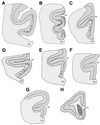A neuronal morphologic type unique to humans and great apes
- PMID: 10220455
- PMCID: PMC21853
- DOI: 10.1073/pnas.96.9.5268
A neuronal morphologic type unique to humans and great apes
Abstract
We report the existence and distribution of an unusual type of projection neuron, a large, spindle-shaped cell, in layer Vb of the anterior cingulate cortex of pongids and hominids. These spindle cells were not observed in any other primate species or any other mammalian taxa, and their volume was correlated with brain volume residuals, a measure of encephalization in higher primates. These observations are of particular interest when considering primate neocortical evolution, as they reveal possible adaptive changes and functional modifications over the last 15-20 million years in the anterior cingulate cortex, a region that plays a major role in the regulation of many aspects of autonomic function and of certain cognitive processes. That in humans these unique neurons have been shown previously to be severely affected in the degenerative process of Alzheimer's disease suggests that some of the differential neuronal susceptibility that occurs in the human brain in the course of age-related dementing illnesses may have appeared only recently during primate evolution.
Figures




References
-
- Frahm H D, Stephan H, Stephan M. J Hirnforsch. 1982;23:375–389. - PubMed
-
- Dunbar R I M. Evol Anthropol. 1998;6:178–190.
-
- Betz W. Zentralbl Med Wiss. 1881;19:193–195. , 209–213, 231–234.
-
- Hammarberg C. Studien über Klinik und Pathologie der Idiotie nebst Untersuchungen über die normale Anatomie des Hirnrinde. Uppsala: Berling; 1895.
-
- Ramón y Cajal S. Textura del Sistema Nervioso del Hombre y de los Vertebrados, Tomo II. Madrid: Nicolás Moya; 1899.
Publication types
MeSH terms
Grants and funding
LinkOut - more resources
Full Text Sources

